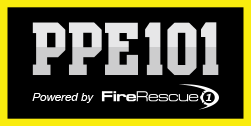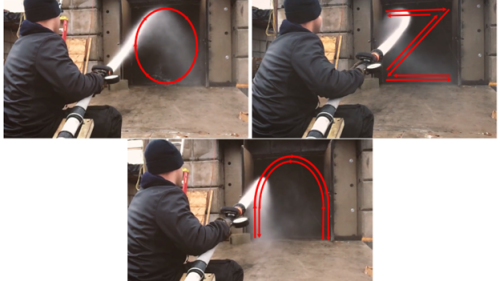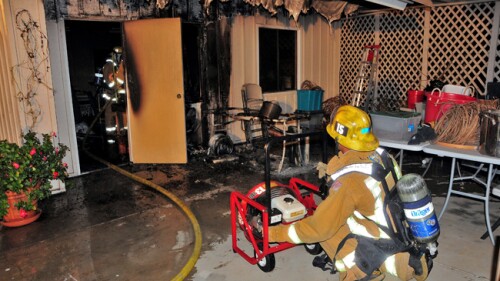
Photo/DALL-E
A time-tested acronym for fire suppression, RECEO-VS stands for Rescue, Exposures, Containment, Extinguishment and Overhaul, with the tacked-on Ventilation and Salvage addressed as a “when needed, where needed” tactical operation.
But as we’ve learned more about the increased risks for firefighters to develop cancers (when compared to the public) from the chemicals, chemical compounds and carcinogens present in the smoke of today’s structural fires, firefighters must reevaluate the importance of ventilation specific to cancer prevention. In short, ventilation is needed any time something has been burning inside a structure.
Beyond flow paths
Controlling the flow path and ventilation to support interior firefighting activities is crucial. But just as crucial is the continued ventilation of all interior spaces where firefighters are working following suppression of the fire (e.g., performing overhaul, property conservation).
Why is ventilation needed then? Aren’t those firefighters being protected by their PPE and SCBA, especially with the emphasis now on breathing air from one’s SCBA until they exit the hazard area? Good questions.
In a 2014 article titled “Systemic Exposure to PAHs and Benzene in Firefighters Suppressing Controlled Structure Fires,” researchers from the Illinois Fire Service Institute and NIOSH found polycyclic aromatic hydrocarbons (PAHs) and other aromatic hydrocarbons present in firefighters after fire suppression and overhaul activities in fire simulations
In other words, you know that interior pressure in the structure that’s being generated by the fire – the pressure that’s forcing smoke and fire gases out of every opening in the building (e.g., windows, doors, eaves) it can find? That same pressure is working to permeate your PPE with those same smoke and fire gases that have those chemicals, chemical compounds and carcinogens. That pressure is forcing these contaminants into the fabric of your PPE and coat and pants, into the soft goods of your helmet and into the interfaces of your PPE (e.g., neck, wrist, legs). And it’s that contamination that’s not going to get completely removed until those PPE elements are properly washed and dried.
Reduce the temperature and reduce the risk of absorption
Then there’s the heat you’re generating heat inside your PPE that’s raising your skin temperature, and the last thing you need is for heat to remain in the spaces where you’re working during overhaul. As Bruce Evans wrote in “Skin’s role in firefighter rehab,” More significant is how these chemicals embed in the pores that open to help thermo-regulate heat stress during firefighting operations. With every 5 degrees that body temperature rises, skin absorption rates increase by as much 400%.
Ventilation sequence
With that information and perspective, it’s imperative that incident commanders (ICs) have two strategies for ventilation when conducting interior structural fire suppression.
The first strategy is to supply tactical ventilation, including controlling the flow path, to support those interior tactical operations (e.g., entry, search, fire containment, fire extinguishment, overhaul). Once those tactical aims have been achieved, the IC must ensure that there is a smooth transition from their first ventilation strategy (tactical ventilation) to their next ventilation strategy – contaminant risk reduction. That transition must include an assessment of the structure’s interior to figure out ventilation needs, allocation of proper resources, and communication of the ventilation plan to everyone on the fire scene.
When developing and supporting such a cancer risk reduction ventilation plan, the IC need not concern themselves with atmospheric monitoring (e.g., four-gas meter, PID). There are no meters that even begin to have the capability to monitor for and test, detect the hundreds, if not thousands, of chemicals, chemical compounds and carcinogens present in those interior spaces, even after the visible smoke has been removed.
As Dawn Bolstad-Johnson wrote in “EXPOSED: Carcinogenic Exposures on the Fireground and 11 Work Practices to Minimize the Risk,” “Firefighters know that CO [carbon monoxide] is toxic and that exposure to CO if they run out of air, can be deadly. This may be why metering for CO before removing their SCBA during overhaul became an acceptable practice … metering for CO does not detect the presence or absence of other toxic concentrations in the fire overhaul environment.” Furthermore, there is no tool that firefighters can use (e.g., four-gas meter, PID meter) to make a decision to work in a post-fire atmosphere in a structure without their PPE and SCBA.
Words matter
Our language has an influence on how we perceive risk. Consider these phrases:
- “It’s just a kitchen fire.”
- “Room and contents fire. No big deal.”
- “Just your bread-and-butter house fire.”
All these scenarios – and more like them – are acute toxic events that are ripe with chemicals, chemical compounds and carcinogens. It’s words and phrases like that that can cause us to let down our guard, and it is never OK to breathe smoke, of any kind, of any amount at any time. Those should be the words that guide our actions and behaviors.
As Bolstad-Johnson writes, “Categorizing smaller fires as low risk may work for a fire attack strategy, in that these types of fires are probably low risk for what is actually going to kill you now. However, they are high in the toxic exposure category for what exposures could kill you later.”
Fire investigators
Likewise, fire investigators conducting their investigation of a fire must also wear a proper level of PPE and breathe air from a SCBA. After all, just because the scene is cold and has been well ventilated during the contaminant reduction phase of ventilation doesn’t mean that all those chemicals, chemical compounds and carcinogens are no longer present.
Bolstad-Johnson and her colleagues with the Phoenix Fire Department conducted two studies that evaluated the toxic hazards that are still present following ventilation of interior spaces during overhaul. The results of those studies showed that airborne concentrations of toxic chemicals and carcinogens, particularly acetaldehyde and formaldehyde, can linger within the structure for extended periods of time and may, in fact, become higher with time rather than lower.
Ventilation did appear to help reduce overall exposures. However, in many cases the concentrations were not reduced to low enough levels to work in this environment without respiratory protection.
Final thoughts
Remember these key points:
- The IC’s first ventilation strategy at a structure fire must deliver tactical ventilation to support interior fire suppression tasks.
- Once fire suppression has been completed, the IC’s ventilation strategy must change, as necessary, to ensure that all interior spaces within the structure where firefighters are working are being sufficiently ventilated.
- Fire investigators also need ventilation when conducting their investigations. Fire departments should create a procedure to supply the proper level of ventilation for contaminant exposure control while fire investigators are working in a structure.







